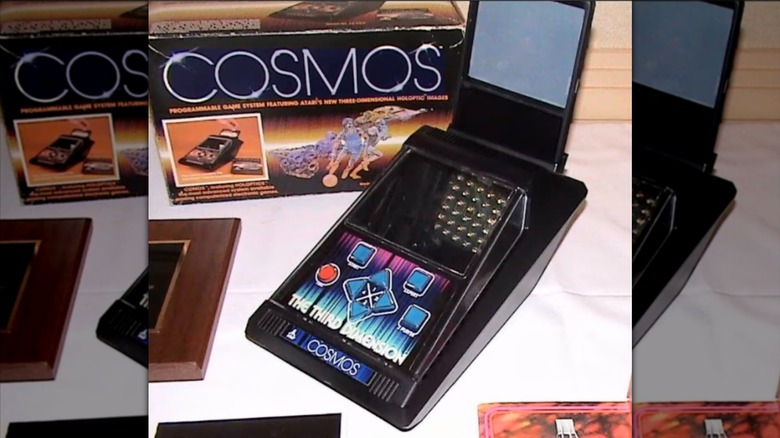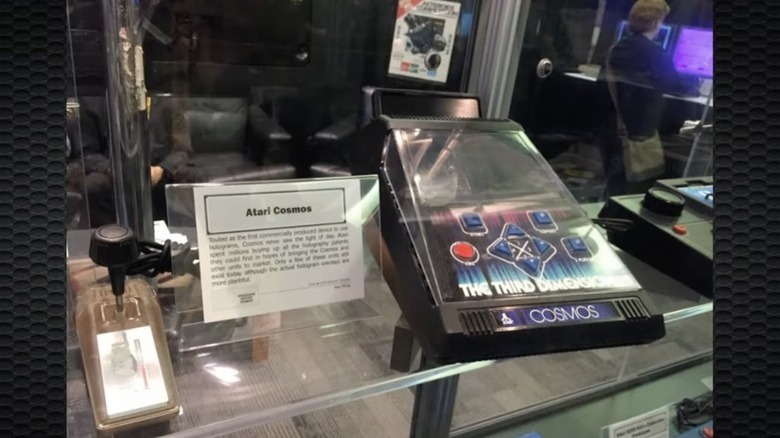Here's What The Ultra-Rare Atari Cosmos Is Worth Today
We may receive a commission on purchases made from links.
The Nintendo Switch is currently one of the most popular consoles on the market, but it wasn't the first to blur the lines between handheld devices and home consoles — those that need to be plugged into a TV to function. In 1980, Atari planned to release a tabletop console called the Atari Cosmos, but canceled the system shortly before its planned release, making it one of many doomed video game consoles axed before public release.
Today, very few remain, which has made the Atari Cosmos super valuable for vintage game collectors, as depicted in 2025's smash hit "A Minecraft Movie." And as with most collectibles, the combination of rarity and quirkiness generally makes a vintage gaming console worth a lot more money, and the Cosmos — which is both ultra-rare and very quirky — is no exception. In 2010, someone found an Atari Cosmos in a California storage unit, and while the Handheld Museum points out it was missing buttons, it sold on eBay for an impressive $7,500.
Of course, that's peanuts compared to what happened in 2024, when a prototype of the Atari Cosmos auctioned for a whopping $25,903. That price is even more astounding considering the console lacks a logic board and is nonfunctional. The device came from the collection of Allan Alcorn, who helped design the Cosmos. The system ultimately became a footnote in the gaming industry, but Alcorn had already cemented his legacy by creating "Pong," the godfather of all video games.
Alcorn was interested in using 3D holograms for Atari's next console and figured out a way to cheaply produce them. The result was a tabletop console about 8 x 13 x 6 inches in size that featured eight buttons directly on the unit: four directional arrow buttons, three black square buttons (Start, Expert, 2 Player), and a bright red Fire button. The Cosmos could play eight or nine preloaded games, including "Space Invaders," "Sea Battle," "Football," and "Superman." A 7 x 6 grid of red LEDs helped create the holographic display, which clearly didn't revolutionize the industry as Alcorn may have hoped.
The rudimentary holograms of the Atari Cosmos didn't wow gamers
While the only playable games for the Cosmos came preloaded with the console, gamers would still need to purchase and insert individual cartridges to play them. That's because the cartridges contained the holographic images for each game, which were created by moving the LED lights behind one of two transparent holographic images that each game cartridge supplied. The result was a green three-dimensional image projected over red figures controlled by the player and moved around the screen. The holographic image could change depending on the gameplay.
According to Allan Alcorn, the rudimentary holography was how Atari could make the Cosmos affordable enough to produce and sell. At the time, expensive lasers were needed to produce holographic images, but Alcorn and his team figured out a way to emboss cheap, metallized Mylar material to achieve a 3D effect. Along with Cosmos co-creators Harry Jenkins and Roger Hector, Alcorn showcased the Cosmos at the New York Toy Fair in 1981. The response was disappointingly tepid — the simple holograms came off more as a gimmick than a revolutionary new way to play video games.
However, Atari still took over 8,000 pre-orders at the trade show. At least 250 units were scheduled to be built. By the time the project was scrapped later that year — possibly due to the lukewarm reception of the technology — Atari had already made packaging and marketing materials for the Cosmos. It's unclear just how many units Atari actually produced, though only six are currently known to exist today. Of those six, three are mockups, and three are considered functional, and that rarity explains why Alcorn's sold for over $25,000.
The Atari Cosmos never launched but still made an impact
The Atari Cosmos may never have made it to store shelves, but it still left an impact — in both good and bad ways. For one thing, it likely contributed to the downfall of Atari, which ceded its domination of the video game industry to Nintendo just a few years later and — despite Atari still being around today — never regained it. Atari CEO Ray Kassar insisted on playing things safe with the wildly successful Atari 2600 rather than take risks with newer, unproven technologies. This alienated the company's creative engineers, including Allan Alcorn, who were more interested in pushing gaming technology. After many of these innovators quit — including Alcorn — Atari lost its hold on the gaming market.
Ultimately, Atari only used the HOLOPTICS technology created for the Cosmos for holographic stickers it placed on its merchandise to differentiate it from counterfeits. Eventually, the American Banknote Corporation began using the cheap holography in a similar fashion on its credit cards and for other secure financial applications. The CPU used for the Atari Cosmos was eventually used in another console: the Entex Adventure Vision.
The Adventure Vision was a tabletop second-generation console that launched in 1982 and looked similar to the Cosmos. Instead of holograms, it used a spinning mirror and a line of red LEDs to create its visuals. This same technique was used over a decade later when Nintendo launched the Virtual Boy. In a case of history repeating itself, the Virtual Boy flopped mainly because gamers saw its red 3D imagery as more of a gimmick than anything else. In the end, the Atari Cosmos cemented its legacy not as a revolutionary new way to play video games but rather as an ultra-rare, very valuable collector's item.

